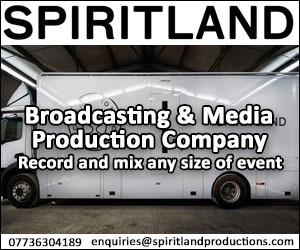Broadcast News
08/11/2013
Standard Deviation: Addressing Loudness On A Global Scale

Despite attempts to standardise a recommended broadcast loudness level across the world, many countries still approach the issue from varying angles, and with varying results, writes Thomas Valter, VP of Business Management, TC Electronic...
Audio loudness in broadcast has been debated intensively in recent years, but for a good reason. The phenomenon that initiated the whole loudness debate has been annoying to viewers – or rather listeners – for many years: systematic jumps in loudness between various types of program material. Loudness is a fundamental audio issue, yet it is also a complex one. Simply measuring the 'energy' of an audio signal in decibel will not give an accurate indication of how loud or soft the human ear 'feels' it is. In other words, 'perceived loudness' is a key term that has in fact been studied intensively by academic researchers, manufacturers and independent organisations in broadcast. Eventually, an international recommendation was established by the International Telecommunication Union (ITU) – the BS.1770 standard – in 2006. Based on massive amounts of listening tests and experiments, this standard became the corner stone that virtually all other broadcast standards build on today. However, there are some fundamental differences between the various standards as well as how each country has decided to interpret and implement them.
Loudness Legislation
It should be noted that only a few countries have actually established concrete legislation on broadcast loudness, but most countries are aware of the issue and recommend following a certain standard – or in other cases, broadcasters want to solve the problem of uneven loudness on a voluntary basis. The most debated law on loudness is the CALM act that was put into effect in the US in December 2012, but France, Italy and Brazil have also passed legislation on loudness in broadcast.
Different Approaches
As mentioned, the ITU BS.1770 standard is the fundamental starting point, but the main standards that are either turned into law or being recommended are the European Broadcasting Union's EBU R128 and Advanced Television Systems Committee's A/85 (the US). There are many differences between these two standards, but overall – and on a fundamental level – R128 measures a given audio signal in full, whereas the approach of A/85 is to use the speech part of an audio signal as an anchor point to determine the overall loudness level.
Both methods can be efficient, but obviously having speech as an anchor point can be problematic if there is no speech involved. Further, determining what is speech and what is not can be challenging when done by an algorithm. Therefore, the CALM act also states that though regular programming is to be measured by speech anchoring, commercials must be measured on a full signal level as determined by BS.1770.
Transmission Versus Production
One could argue that having a loudness correction processor inserted at the end of the audio transmission chain would do the trick altogether. In theory that could be a solution that would keep broadcasters within regulations, but it could also risk being at the cost of the audio quality and thereby listener experience – which might then again turn to new listener complaints. A better approach – and what the EBU is also recommending – is to be aware of the loudness all the way from production over ingest and to the actual transmission. In other words, if loudness is being measured at every stage and adjusted manually without applying unnecessary compressing or limiting, it will not be necessary to correct loudness at the point of transmission, and the audio would not suffer from being processed over and over again.
This, of course, only applies to productions that are not transmitted live, so for that reason – and in general as a safety net – loudness-correcting processors are definitely relevant to have inserted at the end of the transmission chain.
At the end of the day, it seems like broadcasters worldwide are taking audio loudness seriously and have a sincere interest in solving the issue, whether they are being forced to by law or not, and that in itself is a very positive development. As with most good things, it often begins with an inner urge to always deliver a great performance and thereby a better end result.
Thomas Valter is VP of Business Management, Broadcast & Production at TC Electronic, one of the leading manufacturers and researchers in the field of audio loudness.
Read the article in the online edition of RFV here.
(IT/CD)
Audio loudness in broadcast has been debated intensively in recent years, but for a good reason. The phenomenon that initiated the whole loudness debate has been annoying to viewers – or rather listeners – for many years: systematic jumps in loudness between various types of program material. Loudness is a fundamental audio issue, yet it is also a complex one. Simply measuring the 'energy' of an audio signal in decibel will not give an accurate indication of how loud or soft the human ear 'feels' it is. In other words, 'perceived loudness' is a key term that has in fact been studied intensively by academic researchers, manufacturers and independent organisations in broadcast. Eventually, an international recommendation was established by the International Telecommunication Union (ITU) – the BS.1770 standard – in 2006. Based on massive amounts of listening tests and experiments, this standard became the corner stone that virtually all other broadcast standards build on today. However, there are some fundamental differences between the various standards as well as how each country has decided to interpret and implement them.
Loudness Legislation
It should be noted that only a few countries have actually established concrete legislation on broadcast loudness, but most countries are aware of the issue and recommend following a certain standard – or in other cases, broadcasters want to solve the problem of uneven loudness on a voluntary basis. The most debated law on loudness is the CALM act that was put into effect in the US in December 2012, but France, Italy and Brazil have also passed legislation on loudness in broadcast.
Different Approaches
As mentioned, the ITU BS.1770 standard is the fundamental starting point, but the main standards that are either turned into law or being recommended are the European Broadcasting Union's EBU R128 and Advanced Television Systems Committee's A/85 (the US). There are many differences between these two standards, but overall – and on a fundamental level – R128 measures a given audio signal in full, whereas the approach of A/85 is to use the speech part of an audio signal as an anchor point to determine the overall loudness level.
Both methods can be efficient, but obviously having speech as an anchor point can be problematic if there is no speech involved. Further, determining what is speech and what is not can be challenging when done by an algorithm. Therefore, the CALM act also states that though regular programming is to be measured by speech anchoring, commercials must be measured on a full signal level as determined by BS.1770.
Transmission Versus Production
One could argue that having a loudness correction processor inserted at the end of the audio transmission chain would do the trick altogether. In theory that could be a solution that would keep broadcasters within regulations, but it could also risk being at the cost of the audio quality and thereby listener experience – which might then again turn to new listener complaints. A better approach – and what the EBU is also recommending – is to be aware of the loudness all the way from production over ingest and to the actual transmission. In other words, if loudness is being measured at every stage and adjusted manually without applying unnecessary compressing or limiting, it will not be necessary to correct loudness at the point of transmission, and the audio would not suffer from being processed over and over again.
This, of course, only applies to productions that are not transmitted live, so for that reason – and in general as a safety net – loudness-correcting processors are definitely relevant to have inserted at the end of the transmission chain.
At the end of the day, it seems like broadcasters worldwide are taking audio loudness seriously and have a sincere interest in solving the issue, whether they are being forced to by law or not, and that in itself is a very positive development. As with most good things, it often begins with an inner urge to always deliver a great performance and thereby a better end result.
Thomas Valter is VP of Business Management, Broadcast & Production at TC Electronic, one of the leading manufacturers and researchers in the field of audio loudness.
Read the article in the online edition of RFV here.
(IT/CD)
Top Related Stories
Click here for the latest broadcast news stories.
14/05/2012
Jünger Audio Makes Audio Loudness Its Focus At Broadcast Asia 2012
Dynamics specialist Jünger Audio will focus on controlling audio loudness in the broadcast chain at this year’s Broadcast Asia convention in Singapore
Jünger Audio Makes Audio Loudness Its Focus At Broadcast Asia 2012
Dynamics specialist Jünger Audio will focus on controlling audio loudness in the broadcast chain at this year’s Broadcast Asia convention in Singapore
27/11/2012
Broadcast & Audio Series' Loudness Summit Approaches
Broadcast & Audio Series, an organization dedicated to developing educational and networking events for the broadcast and professional audio industrie
Broadcast & Audio Series' Loudness Summit Approaches
Broadcast & Audio Series, an organization dedicated to developing educational and networking events for the broadcast and professional audio industrie
21/11/2012
The Broadcast & Audio Series Loudness Summit Countdown Begins
A top level conference and networking opportunity bringing together leading industry players to analyse, debate and discuss loudness in production wor
The Broadcast & Audio Series Loudness Summit Countdown Begins
A top level conference and networking opportunity bringing together leading industry players to analyse, debate and discuss loudness in production wor
19/07/2012
Jünger Audio Makes Audio Loudness Its Focus At BIRTV 2012
Dynamics specialist Jünger Audio will focus on controlling audio loudness in the broadcast chain at this year’s BIRTV convention in China (August 22nd
Jünger Audio Makes Audio Loudness Its Focus At BIRTV 2012
Dynamics specialist Jünger Audio will focus on controlling audio loudness in the broadcast chain at this year’s BIRTV convention in China (August 22nd
28/01/2013
NUGEN Audio At BVE 2013
At BVE 2013, NUGEN Audio will showcase its complete line of industry-leading solutions for loudness correction that offer a smarter approach to meetin
NUGEN Audio At BVE 2013
At BVE 2013, NUGEN Audio will showcase its complete line of industry-leading solutions for loudness correction that offer a smarter approach to meetin
24/01/2013
NUGEN Audio At BVE 2013
At BVE 2013, NUGEN Audio will showcase its complete line of industry-leading solutions for loudness correction that offer a smarter approach to meetin
NUGEN Audio At BVE 2013
At BVE 2013, NUGEN Audio will showcase its complete line of industry-leading solutions for loudness correction that offer a smarter approach to meetin
04/10/2013
ZEN And The Art Of Loudness Metering
Television loudness has been a viewer’s concern for decades, but recent ITU standardisation has focussed the attention of programme creators on achiev
ZEN And The Art Of Loudness Metering
Television loudness has been a viewer’s concern for decades, but recent ITU standardisation has focussed the attention of programme creators on achiev
05/02/2014
NUGEN Audio Prepares For BVE 2014
NUGEN Audio is to showcase a range of its products, including the new MultiMonitor software for loudness and true-peak monitoring, at this year's BVE
NUGEN Audio Prepares For BVE 2014
NUGEN Audio is to showcase a range of its products, including the new MultiMonitor software for loudness and true-peak monitoring, at this year's BVE
11/11/2016
What Is The Future For Immersive Audio?
Peter Poers, Managing Director at Jünger Audio, looks at production efforts versus consumer experience. Introduction Along with the evolution of highe
What Is The Future For Immersive Audio?
Peter Poers, Managing Director at Jünger Audio, looks at production efforts versus consumer experience. Introduction Along with the evolution of highe
03/07/2015
Turning Up The Volume
Picking up from Issue 225, we're once again looking at Broadcast Audio, particularly at loudness metering and mixing consoles – and how the industry i
Turning Up The Volume
Picking up from Issue 225, we're once again looking at Broadcast Audio, particularly at loudness metering and mixing consoles – and how the industry i
26/03/2014
NUGEN Audio To Unveil Complete Family Of Solutions At NAB 2014
With a special emphasis on the emerging loudness requirements of American broadcasters, NUGEN Audio is presenting its complete family of industry-lead
NUGEN Audio To Unveil Complete Family Of Solutions At NAB 2014
With a special emphasis on the emerging loudness requirements of American broadcasters, NUGEN Audio is presenting its complete family of industry-lead
06/06/2012
TC Electronic Adds Off-line Measuring To Its LM6 Radar Loudness Meter
Existing LM6 users can now upgrade to version 1.1 and get access to the AudioSuite off-line feature, which allows for measuring a full track at a spee
TC Electronic Adds Off-line Measuring To Its LM6 Radar Loudness Meter
Existing LM6 users can now upgrade to version 1.1 and get access to the AudioSuite off-line feature, which allows for measuring a full track at a spee
10/04/2015
NUGEN Audio Releases Loudness Toolkit 2
NUGEN Audio has released Loudness Toolkit 2, the latest generation of the company's suite of loudness metering and correction tools. Consisting of the
NUGEN Audio Releases Loudness Toolkit 2
NUGEN Audio has released Loudness Toolkit 2, the latest generation of the company's suite of loudness metering and correction tools. Consisting of the
29/05/2009
DK-Technologies Helps Independent Media Distribution Comply With BCAP Guidelines
Independent Media Distribution (IMD) has installed a DK-Technologies MSD600M++ with an sdi de-embedder card, which is being used as part of a suite of
DK-Technologies Helps Independent Media Distribution Comply With BCAP Guidelines
Independent Media Distribution (IMD) has installed a DK-Technologies MSD600M++ with an sdi de-embedder card, which is being used as part of a suite of
03/09/2018
Signum Audio To Unveil New Bute Loudness Normaliser At IBC
Scotland-based developer Signum Audio is to unveil its new Bute Loudness Normaliser at the upcoming IBC 2018 (Stand 9.LP30). Bute Loudness Normaliser
Signum Audio To Unveil New Bute Loudness Normaliser At IBC
Scotland-based developer Signum Audio is to unveil its new Bute Loudness Normaliser at the upcoming IBC 2018 (Stand 9.LP30). Bute Loudness Normaliser















